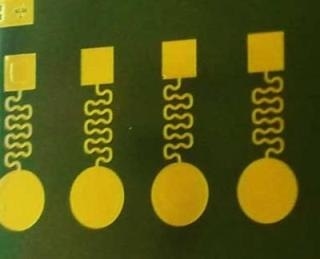Mar 15 2016
As intricate electronics continue to develop, tools are also needed to fix them. In anticipation of this challenge, and inspired by the human body’s immune system, scientists have developed self-propelled nanomotors that locate and repair tiny scratches in the electronics systems. This development can lead to electrodes, solar cells, flexible batteries, and other devices to heal themselves.
 Gold circuits and other electronic components could one day be healed by self-propelled nanomotors. Credit: Wang lab (UCSD)
Gold circuits and other electronic components could one day be healed by self-propelled nanomotors. Credit: Wang lab (UCSD)
At the American Chemical Society’s (ACS) 251st National Meeting & Exposition, this research work was presented. ACS is the world’s largest scientific society, and the exposition will feature more than 12,500 presentations on various scientific topics.
Electronic circuits are very sophisticated these days, but a crack, even an extremely small one, can interrupt the flow of current and eventually lead to the failure of a device. Traditional electronics can be fixed with soldering, but repairing advanced electronics on a nanoscale requires innovation.
Jinxing Li, Ph.D Candidate, University of California
Gadgets will soon be more present than ever, appearing as implants, accessories, and on clothes, says Li, a Ph.D. candidate in the lab of Joseph Wang, D.Sc., at the University of California at San Diego. The challenge is to find a method to repair battery electrodes, nanocircuits or other electronic components, when they are damaged.
Replacing the device or components can be costly and could be difficult, especially when they are positioned in remote places or integrated with clothes. It would be ideal if devices that can repair themselves are created says Wang, whose lab is engaged in the development of nanoscale machines. To achieve this objective, his lab and others looked at nature for ideas.
If you cut your finger, for example, platelets will automatically localize at the wound location and help start the healing process. So what we wanted to do is create and use extremely small robots to perform the same function, except in an electronic system.
Jinxing Li, Ph.D Candidate, University of California
To do this Wang’s group collaborated with the team of Anna Balazs, Ph.D., from the University of Pittsburgh. Her team designed and developed nanoparticles in platinum and gold, fuelled by hydrogen peroxide. Platinum makes hydrogen peroxide split into oxygen and water, to propel the particles. During testing it was realized that nanomotors moved across the broken electronic circuit, which was linked to a light-emitting diode (LED). The nanomotors settled at the crack position, and covered the gap between the adjacent sides. As the nanoparticles were made of electrical conducting materials, the flow of current resumed and the LED lit up.
According to Li, the nanomotors are best suitable for difficult-to-repair electronic components, including the conductive layer of solar cells. Due to extreme environmental conditions, the layers are scratch-prone. Nanomotors can also heal batteries and flexible sensors being developed by the Wang lab.
The concept of different materials and fuels can also be utilized for medical applications to deliver drugs to precise locations. Treatment of diseases such as stomach infections by deploying nanomotors in the body is also being explored by the lab.
The U.S. Department of Energy and the Kavli Institute for Brain and Mind provided funds for the research.